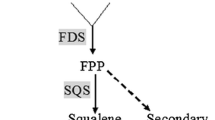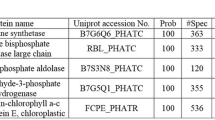Abstract
Ashbya gossypii carries only a single gene (TEF) coding for the abundant translation elongation factor 1α. Cloning and sequencing of this gene and deletion analysis of the promoter region revealed an extremely high degree of similarity with the well studied TEF genes of the yeast Saccharomyces cerevisiae including promoter upstream activation sequence (UAS) elements. The open reading frames in both species are 458 codons long and show 88.6% identity at the DNA level and 93.7% identity at the protein level. A short DNA segment in the promoter, between nucleotides -268 and -213 upstream of the ATG start codon, is essential for high-level expression of the A. gossypii TEF gene. It carries two sequences, GCCCATACAT and ATCCATACAT, with high homology to the UASrpg sequence of S. cerevisiae, which is an essential promoter element in genes coding for highly expressed components of the translational apparatus. UASrpg sequences are binding sites for the S. cerevisiae protein TUF, also called RAP1 or GRF1. In gel retardation with A. gossypii protein extracts we demonstrated specific protein binding to the short TEF promoter segment carrying the UASrpg homologous sequences.
Similar content being viewed by others
References
Alting-Mees MA, Short JM (1989) pBluescript II: gene mapping vectors. Nucleic Acids Res 17:9494
Ashby SF, Nowell W (1926) The fungi of stigmatomycosis. Ann Botany 40:69–84
Axelos M, Bardet C, Liboz T, Van Thai AL, Curie C, Lescure B (1989) The gene family encoding the Arabidopsis thaliana translation elongation factor EF-1α: molecular cloning, characterization and expression. Mol Gen Genet 219:106–112
Bacher A, Van QL, Keller PJ, Floss HG (1983) Biosynthesis of riboflavin. Incorporation of 13C labeled precursors into the xylene ring. Proc Natl Acad Sci USA 258:13431–13437
Ballance DJ (1986) Sequences important for gene expression in filamentous fungi. Yeast 2:229–236
Bennetzen JL, Hall BD (1982) Codon selection in yeast. J Biol Chem 257:3026–3031
Bergkamp-Steffens GK, Hoekstra R, Planta RJ (1992) Structural and putative regulatory sequences of Kluyveromyces ribosomal protein genes. Yeast 8:903–922
Bradford MM (1976) A rapid and sensitive method for the quantitation of microgram quantities of protein utilizing the principle of protein-dye binding. Anal Biochem 72:248–254
Buchman AR, Kimmerly WJ, Rine J, Kornberg RD (1988) Two DNA-binding factors recognize specific sequences at silencers, upstream activating sequences, autonomously replicating sequences, and telomeres in Saccharomyces cerevisiae. Mol Cell Biol 8:210–225
Bullock WO, Fernandez JM, Short JM (1987) XL1-Blue: A high efficiency plasmid transforming recA Escherichia coli strain with beta-galactosidase selection. BioTechniques 5:376–378
Burmester A, Woestemeyer A, Woestemeyer J (1991) [Sequence of the Absidia glauca tef-1 gene for elongation factor 1α.] EMBL Data Library, Accession number X54730
Chen XJ, Fukuhara H (1988) A gene fusion system using the aminoglycoside 3′-phosphotransferase gene of the kanamycinresistance transposon TOO: use in the yeasts Kluyveromyces lactis and Saccharomyces cerevisiae. Gene 69:181–192
Cottrelle P, Thiele D, Price VL, Memet S, Micouin J-Y, Marck C, Buhler J-M, Sentenac A, Fromageot P (1985) Cloning, nucleotide sequence, and expression of one of two genes coding for yeast elongation factor 1α. J Biol Chem 260:3090–3096
Demain AL (1972) Riboflavin oversynthesis. Annu Rev Microbiol 26:369–388
Fincham JRS (1989) Transformation in fungi. Microbiol Rev 53:148–170
Fried M, Crothers DM (1981) Equilibria and kinetics of lac repressor-operator interactions by polyacrylamide gel electrophoresis. Nucleic Acids Res 9:6505–6525
Garner MM, Revzin A (1981) A gel electrophoresis method for quantifying the binding of proteins to specific DNA regions: application to components of the Escherichia coli lactose operon regulatory system. Nucleic Acids Res 9:3047–3060
Henikoff S (1984) Unidirectional digestion with exonuclease III creates targeted breakpoints for DNA sequencing. Gene 28:351–359
Henikoff S, Kelly JD, Cohen EH (1983) Transcription terminates in yeast distal to a control sequence. Cell 33:607–614
Huet J, Sentenac A (1987) TUF, the yeast DNA-binding factor specific for UASrpg upstream activating sequences: Identification of the protein and its DNA-binding domain. Proc Natl Acad Sci USA 84:3648–3652
Huct J, Cottrelle P, Cool M, Vignais M-L, Thiele D, Marck C, Buhler JM, Sentenac A, Fromageot P (1985) A general upstream binding factor for genes of the yeast translational apparatus. EMBO J 4:3539–3547
Jaskurnas SR, Lindahl L, Nomura M, Burgess RR (1975) Identification of two copies of the gene for the elongation factor EF-Tu in E. coli. Nature 257:458–462
Jiang W, Philippsen P (1989) Purification of a protein binding to the CDEI subregion of Saccharomyces cerevisiae centromere DNA. Mol Cell Biol 9:5585–5593
Jimenez A, Davies J (1980) Expression of a transposable antibiotic resistance element in Saccharomyces. Nature 287:869–871
Keller PJ, Van QL, Kim S, Born DH, Chen H, Kohnle A, Bacher A, Floss HG (1988) Biosynthesis of riboflavin: mechanism of formation of the ribitylamino linkage. Biochemistry 27:1117–1120
Kim DW, Uetsuki T, Kaziro Y, Yamaguchi N, Sugano S (1990) Use of the human elongation factor 1α promoter as a versatile and efficient expression system. Gene 91:217–223
Leer RJ, van Raamsdonk-Duin MMC, Mager WH, Planta RL (1985) Conserved sequences upstream of yeast ribosomal protein genes. Curr Genet 9:273–277
Linz JE, Katayama C, Sypherd PS (1986a) Three genes for the elongation factor EF-1α in Mucor racemosus. Mol Cell Biol 6:593–600
Linz JE, Lira LM, Sypherd PS (1986b) The primary structure and the functional domains of an elongation factor-1α from Mucor racemosus. J Biol Chem 261:15022–15029
Lodder J (1970) General classification of the yeasts. In: Lodder J (ed) The yeasts. North-Holland Publishing Company, Amsterdam-London, pp 1–30
Madsen HO, Poulsen K, Dahl O, Clark BFC, Hjorth JP (1990) Retropseudogenes constitute the major part of the human elongation factor la gene family. Nucleic Acids Res 18:1513–1516
Miller JH (1972) Experiments in molecular genetics. Cold Spring Harbor Laboratory Press, Cold Spring Harbor, New York
Nagata S, Nagashima K, Tsunetsugu-Yokota Y, Fujimura K, Miyazaki M, Kaziro Y (1984) Polypeptide chain elongation factor 1α (EF-1α) from yeast: nucleotide sequence of one of the two genes for EF-1α from Saccharomyces cerevisiae. EMBO J 3:1825–1830
Pearson WR, Lipman DJ (1988) Improved tools for biological sequence comparison. Proc Natl Acad Sci USA 85:2444–2448
Proudfoot NJ, Brownlee GG (1976) 3′ Non-coding region sequences in eukaryotic messenger RNA. Nature 263:211–214
Rose M, Casadaban MJ, Botstein D (1981) Yeast genes fused to β-galactosidase in Escherichia coli can be expressed normally in yeast. Proc Natl Acad Sci USA 78:2460–2464
Russel M, Kidd S, Kelley MR (1986) An improved filamentous helper phage for generating single-stranded plasmid DNA. Gene 45:333–338
Sambrook J, Fritsch EF, Maniatis T (1989) Molecular cloning: a laboratory manual, 2nd edn. Cold Spring Harbor Laboratory Press, Cold Spring Harbor, New York
Sanger F, Nicklen S, Coulson AR (1977) DNA sequencing with chain-terminating inhibitors. Proc Natl Acad Sci USA 74:5463–5467
Schirmaier F, Philippsen P (1984) Identification of two genes coding for the translation elongation factor EF-1α of S. cerevisiae. EMBO J 3:3311–3315
Shapira SK, Chou J, Richaud FV, Casadaban MJ (1983) New versatile plasmid vectors for expression of hybrid proteins coded by a cloned gene fused to lacZ gene sequences encoding an enzymatically active carboxy-terminal portion of β-galactosidase. Gene 25:71–82
Sharp PM, Cowe E, Higgins DG, Shields DC, Wolfe KH, Wright F (1988) Codon usage patterns in Escherichia coli, Bacillus subtilis, Saccharomyces cerevisiae, Schizosaccharomyces pombe, Drosophila melanogaster and Homo sapiens; a review of the considerable within-species diversity. Nucleic Acids Res 16:8207–8211
Shi Y, Tyler BM (1991) Coordinate expression of ribosomal protein genes in Neurospora crassa and identification of conserved upstream sequences. Nucleic Acids Res 10:6511–6517
Shore D, Nasmyth K (1987) Purification and cloning of a DNA binding protein from yeast that binds to both silencer and activator elements. Cell 51:721–732
Short JM, Fernandez JM, Shoge JA, Huse WD (1988) λZAP: a bacteriophage λ expression vector with in vivo excision properties. Nucleic Acids Res 16:7583–7600
Slobin LI (1980) The role of eukaryotic elongation factor Tu in protein synthesis. Eur J Biochem 110:555–563
Sundstrom P, Smith D, Syphert PS (1990) Sequence analysis and expression of the two genes for elongation factor la from the dimorphic yeast Candida albicans. J Bacteriol 172:2036–2045
Teem JL, Abovich N, Kaufer NF, Schwindinger WF, Warner JR, Levy A, Woolford J, Leer RJ, van Raamsdonk-Duin MMC, Mager WH, Planta RJ, Schultz L, Friesen JD, Fried H, Rosbash M (1984) A comparison of yeast ribosomal protein gene DNA sequences. Nucleic Acids Res 12:8295–8312
Tyler SM, Harrison K (1990) Neurospora crassa ribosomal protein gene, homologous to yeast CRY1, contains sequences potentially coordinating its transcription with rRN genes. Nucleic Acids Res 18:5759–5765
Ursin VM, Irvine JM, Hiatt WR, Shewmaker CK (1991) Developmental analysis of elongation-factor-1α expression in transgenic tobacco. Plant Cell 3:538–591
Van Hemert FJ, Amons R, Pluijms WJM, van Ormondt H, Möller W (1984) The primary structure of elongation factor EF-1α from the brine shrimp Artemia. EMBO J 3:1109–1113
Vignais M-L, Woudt LP, Wassenaar GM, Mager WH, Sentenac A, Planta RJ (1987) Specific binding of TUF factor to upstream activation sites of yeast ribosomal protein genes. EMBO J 6:1451–1457
Vignais M-L, Huet J, Buhler J-M, Sentenac A (1990) Contacts between the factor TUF and RPG sequences. J Biol Chem 265:14669–14674
Walldorf U, Hovemann BT (1990) Apis mellifera cytoplasmatic elongation factor 1α (EF-1α) is closely related to Drosophila melanogaster EF-1α. FEBS Lett 267:245–249
Wickerham LJ, Flickinger MH, Johnston RM (1946) The production of riboflavin by Ashbya gossypii. Arch Biochem 9:95–98
Woudt LP, Smit AB, Mager WH, Planta RJ (1986) Conserved sequence elements upstream of the gene encoding yeast ribosomal protein L25 are involved in transcription activation. EMBO J 5:1037–1040
Woudt LP, Mager WH, Nieuwint RTM, Wassenaar GM, van der Kuyl AC, Murre JJ, Hoekman MFM, Brockhoff PGM, Planta RJ (1987) Analysis of upstream activating sites of yeast ribosomal protein genes. Nucleic Acids Res 15:6037–6048
Wright M, Philippsen P (1991) Replicative transformation of the filamentous fungus Ashbya gossypii with plasmids containing Saccharomyces cerevisiae ARS elements. Gene 109:99–105
Yanisch-Perron C, Vieira J, Messing J (1985) Improved M13 phage cloning vectors and host strains: nucleotide sequence of the M13mp18 and pUC19 vectors. Gene 33:103–119
Zaret KS, Sherman F (1982) DNA sequence required for efficient transcription termination in yeast. Cell 28:563–573
Author information
Authors and Affiliations
Additional information
Communicated by C.P. Hollenberg
Rights and permissions
About this article
Cite this article
Steiner, S., Philippsen, P. Sequence and promoter analysis of the highly expressed TEF gene of the filamentous fungus Ashbya gossypii . Molec. Gen. Genet. 242, 263–271 (1994). https://doi.org/10.1007/BF00280415
Received:
Accepted:
Issue Date:
DOI: https://doi.org/10.1007/BF00280415




